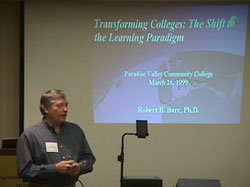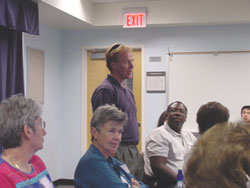Convergence

In November 1995, an article appeared in Change magazine, “From Teaching to Learning – A New Paradigm for Undergraduate Education,” by Robert B. Barr and John Tagg.
“A paradigm shift is taking hold in American higher education…A college is an institution that exists to provide instruction. Subtly but profoundly, we are shifting to a new paradigm. A college is an institution that exists to produce learning. This shift changes everything.”
This article created great controversy in the higher educational community when it was first published. After many discussions at PVCC we came to think of this concept as being on a continuum based upon the specific needs of the employee and student within the teaching and learning relationship.

- Provide/deliver instruction
- Transfer knowledge
- Achieve access for diverse students
- Structured nonflexible time and space
- Material covered
- Produce learning
- Construction of knowledge
- Achieve success for diverse students
- Flexibility in learning time and space
- Specified learning results
Barr, R. B. & Tagg, J. (1995, November/December). From teaching to learning--a new paradigm for undergraduate education. Change Magazine, 27 (6): 12-25.
Then in 1997, The League for Innovation and Terry O’Banion published the “A Learning College for the 21st Century” book.
“Colleges that change their basic systems to focus on learning by expanding learning options for students, by engaging students as full partners in the learning process, by designing educational structures to meet learner needs, and by defining the roles of learner facilitators based on the needs of learners, will create an educational enterprise that will help students make passionate connections to learning…the learning college that places learning first and provides educational experiences for learners anyway, anyplace, anytime has great potential for fulfilling this dream.”
Again this can be viewed along a continuum based upon the specific needs of the employee and student within the teaching and learning relationship.

- Creates substantive change in learners
- Engages learners in the learning process
- Creates and offers as many options as possible
- Assists learners to form and participate in collaborative learning activities
- Defines the role of learning facilitators by the needs of learners
- Learning facilitators succeed when improved and expanded learning can be documented
O'Banion, Terry. A Learning College for the 21st Century. Phoenix, AZ: Oryx, 1997. Print.
At this point, the college then looked to Peter Senge and his work around organizational learning to help PVCC

provide a context for the final piece in the learning centered college journey.
Learning Organization
- Personal Mastery
- Mental Models
- Shared Vision
- Team Learning
- Systems Thinking
- Looking at the whole
- Exploring patterns, connections, and relationships.
- Considering processes, procedures, and structures.
- Aligning core value of learning to systems, processes and procedures.
It is in the confluence of these three key concepts, paradigm shift, the learning college and the learning organization along with our own internal conversations around learning is how PVCC began its journey to become a more learning centered college. Please see the LCC in Action for additional information.
Senge, Peter. Schools That Learn. London: Nicholas Brealey, 2000. Print.